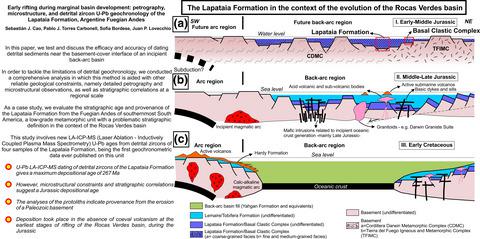当前位置:
X-MOL 学术
›
Basin Res.
›
论文详情
Our official English website, www.x-mol.net, welcomes your
feedback! (Note: you will need to create a separate account there.)
Early rifting during marginal basin development: Petrography, microstructure, and detrital zircon U-Pb geochronology of the Lapataia Formation, Argentine Fuegian Andes
Basin Research ( IF 2.8 ) Pub Date : 2022-03-11 , DOI: 10.1111/bre.12664 Sebastián J. Cao 1, 2 , Pablo J. Torres Carbonell 1 , Sofía Bordese 3 , Juan P. Lovecchio 4
Basin Research ( IF 2.8 ) Pub Date : 2022-03-11 , DOI: 10.1111/bre.12664 Sebastián J. Cao 1, 2 , Pablo J. Torres Carbonell 1 , Sofía Bordese 3 , Juan P. Lovecchio 4
Affiliation

|
Although being one of the most efficient tools to constrain the stratigraphy of sedimentary basins, detrital zircon geochronology may present limitations under certain conditions, and isotopic ages should be treated with caution before assigning a depositional age. This is the case of depositional environments that lack coeval volcanism, where there may exist a significant time gap between the age of the youngest detrital zircon available and the actual time of deposition of a sedimentary rock. In this paper, we put on a comprehensive analysis in which detrital geochronology is aided with other reliable geological constraints. As a case study, we evaluate the stratigraphic age and provenance of the Lapataia Formation from the Fuegian Andes of southernmost South America, a low-grade metamorphic unit with a problematic stratigraphic definition in the context of the Rocas Verdes basin. Detrital ages show very wide age spectra, with a younger peak at ca. 267 Ma. However, based on detailed petrography and microstructural observations, as well as stratigraphic correlations at a regional scale, we conclude that the Lapataia Formation represents the earliest stages of Jurassic rifting during the opening of the Rocas Verdes basin. Erosion from older basement blocks in an environment lacking coeval volcanic activity explains the occurrence of Paleozoic and older grains, and the lack of younger zircons. This work offers a multifaceted approach, which may be essential to assist radiometric detrital geochronology at certain stages during basin evolution.
中文翻译:

边缘盆地发育过程中的早期裂谷作用:阿根廷富地安第斯山脉 Lapataia 组的岩石学、微观结构和碎屑锆石 U-Pb 年代学
虽然是限制沉积盆地地层学的最有效工具之一,但碎屑锆石地质年代学在某些条件下可能存在局限性,在确定沉积年龄之前应谨慎处理同位素年龄。这是缺乏同时代火山活动的沉积环境的情况,其中最年轻的碎屑锆石的年龄与沉积岩的实际沉积时间之间可能存在显着的时间差距。在本文中,我们进行了综合分析,其中碎屑地质年代学与其他可靠的地质约束条件相辅相成。作为一个案例研究,我们评估了南美洲最南端 Fuegian Andes 的 Lapataia 组的地层年龄和物源,在 Rocas Verdes 盆地的背景下,地层定义有问题的低品位变质单元。碎屑年龄显示出非常宽的年龄谱,在 ca 处有一个较年轻的峰值。267 马。然而,基于详细的岩石学和微观结构观察,以及区域尺度的地层对比,我们得出结论,Lapataia 组代表了 Rocas Verdes 盆地开放期间侏罗纪裂谷的最早阶段。在缺乏同时代火山活动的环境中,较老的地下室块体的侵蚀解释了古生代和较老的晶粒的出现,以及年轻锆石的缺乏。这项工作提供了一种多方面的方法,这对于协助盆地演化过程中某些阶段的辐射碎屑地质年代学可能是必不可少的。碎屑年龄显示出非常宽的年龄谱,在 ca 处有一个较年轻的峰值。267 马。然而,基于详细的岩石学和微观结构观察,以及区域尺度的地层对比,我们得出结论,Lapataia 组代表了 Rocas Verdes 盆地开放期间侏罗纪裂谷的最早阶段。在缺乏同时代火山活动的环境中,较老的地下室块体的侵蚀解释了古生代和较老的晶粒的出现,以及年轻锆石的缺乏。这项工作提供了一种多方面的方法,这对于协助盆地演化过程中某些阶段的辐射碎屑地质年代学可能是必不可少的。碎屑年龄显示出非常宽的年龄谱,在 ca 处有一个较年轻的峰值。267 马。然而,基于详细的岩石学和微观结构观察,以及区域尺度的地层对比,我们得出结论,Lapataia 组代表了 Rocas Verdes 盆地开放期间侏罗纪裂谷的最早阶段。在缺乏同时代火山活动的环境中,较老的地下室块体的侵蚀解释了古生代和较老的晶粒的出现,以及年轻锆石的缺乏。这项工作提供了一种多方面的方法,这对于协助盆地演化过程中某些阶段的辐射碎屑地质年代学可能是必不可少的。我们得出结论,Lapataia 组代表了 Rocas Verdes 盆地开放期间侏罗纪裂谷的最早阶段。在缺乏同时代火山活动的环境中,较老的地下室块体的侵蚀解释了古生代和较老的晶粒的出现,以及年轻锆石的缺乏。这项工作提供了一种多方面的方法,这对于协助盆地演化过程中某些阶段的辐射碎屑地质年代学可能是必不可少的。我们得出结论,Lapataia 组代表了 Rocas Verdes 盆地开放期间侏罗纪裂谷的最早阶段。在缺乏同时代火山活动的环境中,较老的地下室块体的侵蚀解释了古生代和较老的晶粒的出现,以及年轻锆石的缺乏。这项工作提供了一种多方面的方法,这对于协助盆地演化过程中某些阶段的辐射碎屑地质年代学可能是必不可少的。
更新日期:2022-03-11
中文翻译:

边缘盆地发育过程中的早期裂谷作用:阿根廷富地安第斯山脉 Lapataia 组的岩石学、微观结构和碎屑锆石 U-Pb 年代学
虽然是限制沉积盆地地层学的最有效工具之一,但碎屑锆石地质年代学在某些条件下可能存在局限性,在确定沉积年龄之前应谨慎处理同位素年龄。这是缺乏同时代火山活动的沉积环境的情况,其中最年轻的碎屑锆石的年龄与沉积岩的实际沉积时间之间可能存在显着的时间差距。在本文中,我们进行了综合分析,其中碎屑地质年代学与其他可靠的地质约束条件相辅相成。作为一个案例研究,我们评估了南美洲最南端 Fuegian Andes 的 Lapataia 组的地层年龄和物源,在 Rocas Verdes 盆地的背景下,地层定义有问题的低品位变质单元。碎屑年龄显示出非常宽的年龄谱,在 ca 处有一个较年轻的峰值。267 马。然而,基于详细的岩石学和微观结构观察,以及区域尺度的地层对比,我们得出结论,Lapataia 组代表了 Rocas Verdes 盆地开放期间侏罗纪裂谷的最早阶段。在缺乏同时代火山活动的环境中,较老的地下室块体的侵蚀解释了古生代和较老的晶粒的出现,以及年轻锆石的缺乏。这项工作提供了一种多方面的方法,这对于协助盆地演化过程中某些阶段的辐射碎屑地质年代学可能是必不可少的。碎屑年龄显示出非常宽的年龄谱,在 ca 处有一个较年轻的峰值。267 马。然而,基于详细的岩石学和微观结构观察,以及区域尺度的地层对比,我们得出结论,Lapataia 组代表了 Rocas Verdes 盆地开放期间侏罗纪裂谷的最早阶段。在缺乏同时代火山活动的环境中,较老的地下室块体的侵蚀解释了古生代和较老的晶粒的出现,以及年轻锆石的缺乏。这项工作提供了一种多方面的方法,这对于协助盆地演化过程中某些阶段的辐射碎屑地质年代学可能是必不可少的。碎屑年龄显示出非常宽的年龄谱,在 ca 处有一个较年轻的峰值。267 马。然而,基于详细的岩石学和微观结构观察,以及区域尺度的地层对比,我们得出结论,Lapataia 组代表了 Rocas Verdes 盆地开放期间侏罗纪裂谷的最早阶段。在缺乏同时代火山活动的环境中,较老的地下室块体的侵蚀解释了古生代和较老的晶粒的出现,以及年轻锆石的缺乏。这项工作提供了一种多方面的方法,这对于协助盆地演化过程中某些阶段的辐射碎屑地质年代学可能是必不可少的。我们得出结论,Lapataia 组代表了 Rocas Verdes 盆地开放期间侏罗纪裂谷的最早阶段。在缺乏同时代火山活动的环境中,较老的地下室块体的侵蚀解释了古生代和较老的晶粒的出现,以及年轻锆石的缺乏。这项工作提供了一种多方面的方法,这对于协助盆地演化过程中某些阶段的辐射碎屑地质年代学可能是必不可少的。我们得出结论,Lapataia 组代表了 Rocas Verdes 盆地开放期间侏罗纪裂谷的最早阶段。在缺乏同时代火山活动的环境中,较老的地下室块体的侵蚀解释了古生代和较老的晶粒的出现,以及年轻锆石的缺乏。这项工作提供了一种多方面的方法,这对于协助盆地演化过程中某些阶段的辐射碎屑地质年代学可能是必不可少的。











































 京公网安备 11010802027423号
京公网安备 11010802027423号